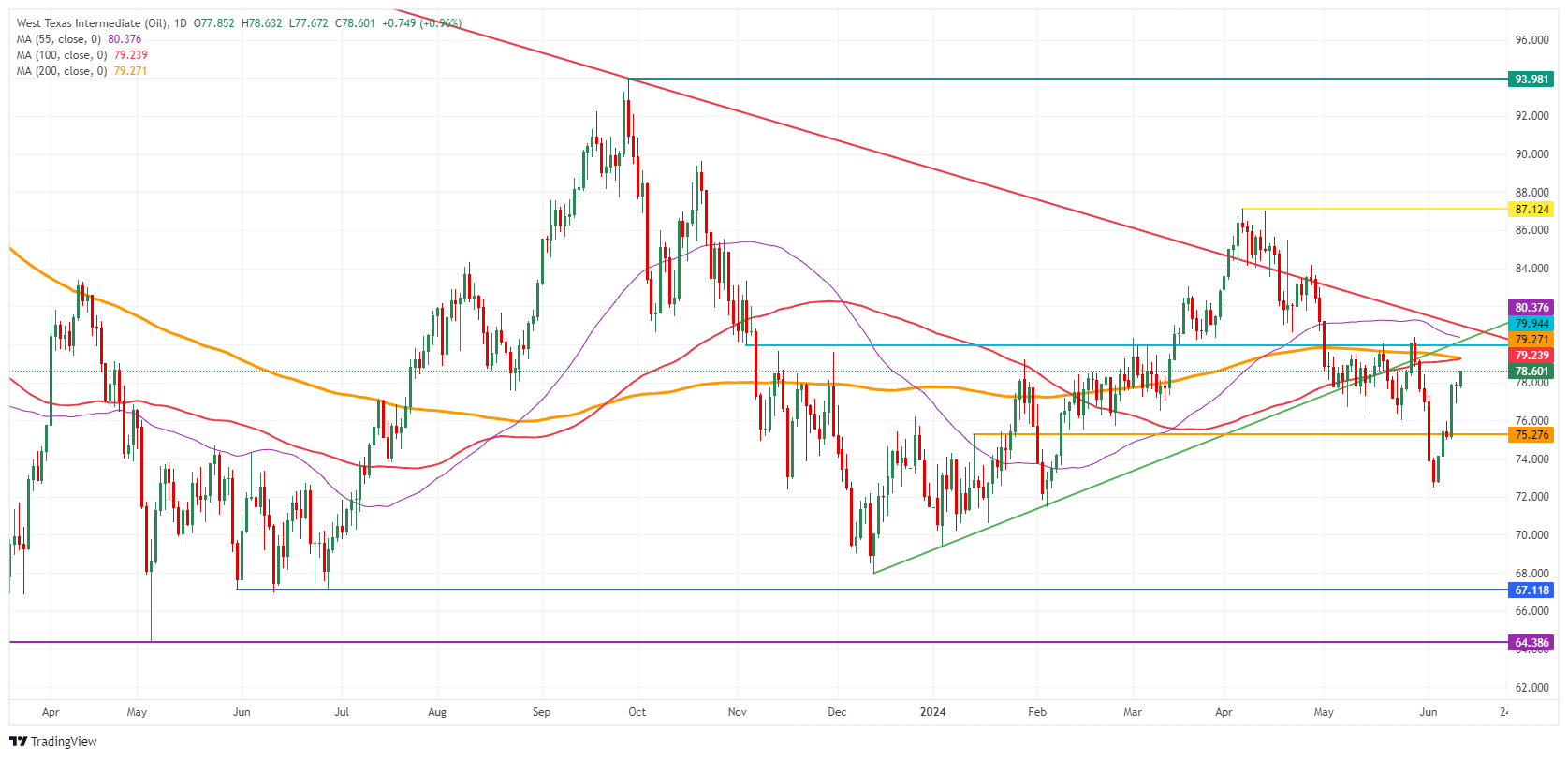Oil recovers towards $80 on declining US inventories

- Oil gains ground on Wednesday ahead of a busy US trading session.
- US API stockpiles data showed a bigger-than-expected decline in inventories.
- The US Dollar Index trades comfortably above 105.00 ahead of US CPI and the Fed’s rate decision.
Oil prices are sprinting higher on Wednesday, touching the highest level since May 30, supported by a larger-than-expected decrease in US inventories. Data from the American Petroleum Institute (API) showed on Tuesday that crude stockpiles declined by 2.428 million barrels in the week ending June 7, well above the 1.75 drawdown expected and swinging from a 4.052 million buildup a week earlier. The Energy Information Administration (EIA) will release its own numbers later this Wednesday, with analysts predicting also a decline in Oil stockpiles.
Meanwhile, the US Dollar Index (DXY) is trading above 105.00 as the dust settles after the political turmoil in Europe, particularly in France, following the results of the parliament elections. Traders are focused on the US data, with the US Consumer Price Index (CPI) numbers ahead of the US opening bell as the main event. This will be followed by the interest-rate decision from the US Federal Reserve (Fed). Although no change in the policy rate is expected, the dot plot projections and the speech from Fed Chairman Jerome Powell could send the DXY in any direction.
At the time of writing, Crude Oil (WTI) trades at $78.28 and Brent Crude at $82.36
Oil news and market movers: Dislocation between price action and option markets
- Option markets flow and positioning still shows traders are unwinding their bullish bets with OPEC+ reopening its production in the fall of 2024 and China demand remaining sluggish, Bloomberg reports.
- Kazakhstan will need to compensate for its additional volume of 45,000 Oil barrels per day as it exceeded its agreed production level within OPEC+. Hence the country will decrease its coming output quota in order to make good on the surplus it released earlier this year, extended until September 2025, Reuters reports.
- At 14:30 GMT, the Energy Information Administration (EIA) will release the weekly Crude stockpile changes. The previous number was a build of 1.233 million barrels, and a drawdown of 1.55 million expected for this week.
Oil Technical Analysis: Fed to kill off any recovery
Oil prices are edging higher, but any further advance hinges on the Fed. Any indication that interest rates could remain higher for longer would kill off any aspirations for Oil traders to jump above $80. Should Fed Chairman Jerome Powell deliver a hawkish speech in terms of no forward guidance, smashing hopes for a rate cut for 2024, a nosedive move in Oil could materialize. As China’s economic recovery is not picking up further, all hopes were placed on the US for a second economic boom and surge in demand. With interest rates remaining high, this might not come, and OPEC+ is set to open up its production back to normal capacity and flood the market.
Looking up, the key two levels ahead of $80.00 are the 100-day and 200-day Simple Moving Averages (SMA) at $79.23 and $79.27, respectively. Next, the 55-day Simple Moving Average (SMA) at $80.37 is a level with a lot of resistance where any recovery rally could pause. Once broken through there, the road looks quite open to head to $87.12.
The $76.00 marker is still acting as a support with the $75.27 level playing a crucial role if traders still want to have an option to head back to $80.00. However, risks are skewed towards another leg lower if the Fed is hawkish, sending Oil further down below $70.00.
US WTI Crude Oil: Daily Chart
WTI Oil FAQs
WTI Oil is a type of Crude Oil sold on international markets. The WTI stands for West Texas Intermediate, one of three major types including Brent and Dubai Crude. WTI is also referred to as “light” and “sweet” because of its relatively low gravity and sulfur content respectively. It is considered a high quality Oil that is easily refined. It is sourced in the United States and distributed via the Cushing hub, which is considered “The Pipeline Crossroads of the World”. It is a benchmark for the Oil market and WTI price is frequently quoted in the media.
Like all assets, supply and demand are the key drivers of WTI Oil price. As such, global growth can be a driver of increased demand and vice versa for weak global growth. Political instability, wars, and sanctions can disrupt supply and impact prices. The decisions of OPEC, a group of major Oil-producing countries, is another key driver of price. The value of the US Dollar influences the price of WTI Crude Oil, since Oil is predominantly traded in US Dollars, thus a weaker US Dollar can make Oil more affordable and vice versa.
The weekly Oil inventory reports published by the American Petroleum Institute (API) and the Energy Information Agency (EIA) impact the price of WTI Oil. Changes in inventories reflect fluctuating supply and demand. If the data shows a drop in inventories it can indicate increased demand, pushing up Oil price. Higher inventories can reflect increased supply, pushing down prices. API’s report is published every Tuesday and EIA’s the day after. Their results are usually similar, falling within 1% of each other 75% of the time. The EIA data is considered more reliable, since it is a government agency.
OPEC (Organization of the Petroleum Exporting Countries) is a group of 13 Oil-producing nations who collectively decide production quotas for member countries at twice-yearly meetings. Their decisions often impact WTI Oil prices. When OPEC decides to lower quotas, it can tighten supply, pushing up Oil prices. When OPEC increases production, it has the opposite effect. OPEC+ refers to an expanded group that includes ten extra non-OPEC members, the most notable of which is Russia.
